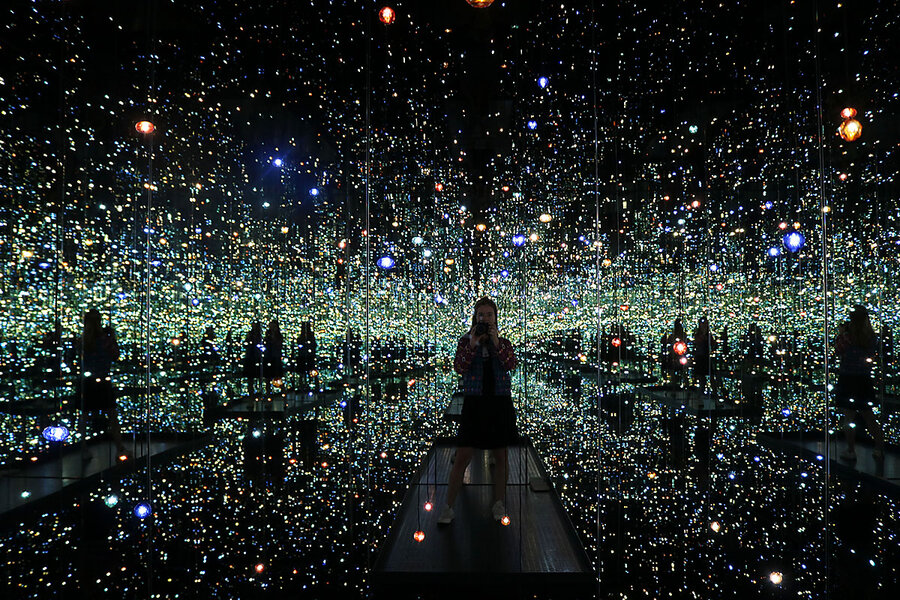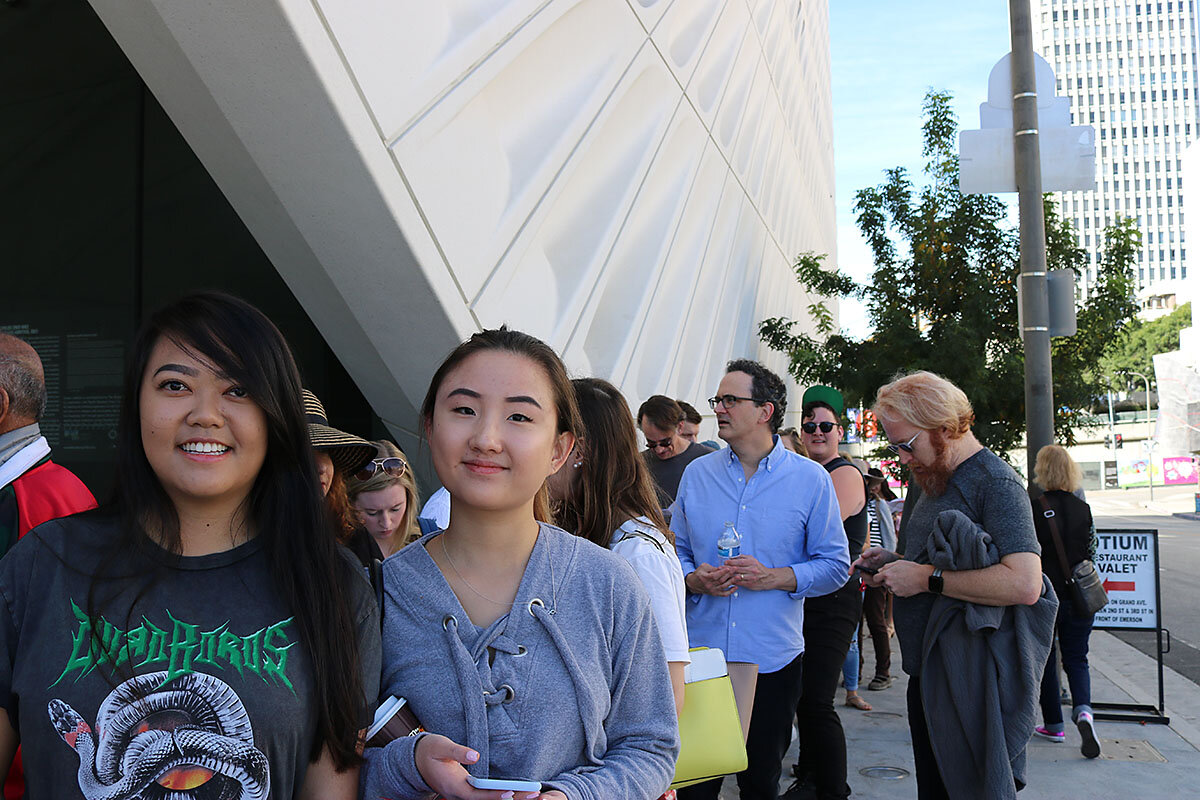Museums woo a new generation with 'Instagram worthy' art
Loading...
| Los Angeles
New York college students Helen Chen and Siyin Li are only visiting Los Angeles for a few days, but they decided to spend their Sunday afternoon in a line that wraps around the block.
“The minute we booked our trip, we bookmarked [The Broad],” says Ms. Chen.
The Broad, a free contemporary art museum in downtown L.A., has welcomed more than 1.7 million visitors since its opening in September 2015. The museum’s popularity has tripled annual expectations, say staff, and they attribute a lot of its success to Yayoi Kusama’s work, both her “Infinity Mirrors” exhibition that was on display last fall and one of the permanent pieces in the museum’s collection, “Infinity Mirrored Room – The Souls of Millions of Light Years Away.”
“It’s an Instagram-worthy shot for sure,” says Ms. Chen, pointing to a picture on her phone that a friend took in Ms. Kusama’s room at The Broad and shared on Instagram. In fact, the hashtag #YayoiKusama has 563,200 posts on the social media site.
“The only reason people know about it is because of Instagram,” says Ms. Li.
That may be true for the Millennials in the crowd, who indicate that they consider the photo opportunity to be the museum’s major draw.
While New York City-based exhibits, such as the Museum of Ice Cream and Refinery29’s 29Rooms, ventured to the West Coast last year and sold out in a matter of minutes, Los Angeles has become a hotbed for Instagram-ready art installations in its own right.
At the Natural History Museum of Los Angeles exhibition, “Tattoo,” visitors can become a part of the exhibit at the on-site tattoo parlor. The pop-up installation “Happy Place”, with the tagline “Capture your happy,” booked out weeks in advance for its picture-perfect confetti rooms and rainbow grilled-cheese sandwiches. And the Museum of Selfies will open in Glendale, Calif., on April 1, where visitors can “explore the origin of the selfie” while taking selfies of their own with interactive installations.
“L.A. is a special area where interactive entertainment is really growing,” says Tommy Honton, who co-created of the Museum of Selfies after working in the escape room industry. “We have all the ingredients other cities may be missing: the artists, creatives, tech investors, and the space. L.A. audiences are savvy, open-minded… and hungry for new forms of entertainment.”
'It’s changed the way people look at art'
The art world is seemingly divided on this trend. Some observers believe that it has reinvigorated the interest of young people in museums and generated necessary ticket sales through free marketing, while others say seeing art through the lens of potential Instagram “likes” is egotistical, disrespectful to the work, and threatens the value of other artwork that isn’t as photogenic.
“The power of Instagram to get people in the door is so seductive to museums. They may think, ‘Okay that’s what works. Why are we not doing more of that?,’ ” says Philip Kennicott, senior art and architecture critic for The Washington Post. “But there is a lot of other stuff in the museum that is maybe not as Instagrammable. Are [young visitors] going to that kind of stuff? Increasingly, I’m skeptical about that.”
Kevin Pobjoy has only worked at The Broad for three months, but he has lost count of how many times he has said, “Please don’t touch.” That familiar museum refrain is more important than ever, as damage from selfies gone wrong can cost hundreds of thousands of dollars.
In the room holding Robert Therrien’s “Under the Table” (a set of table and chairs 18-feet-high) a visitor approaches Mr. Pobjoy and all she says is “Can you – ,” before he stretches out his hand for her camera phone. He even helps stage her photo: “The best place for a photo is by this chair, where the shadows meet.”
“It’s changed the way people look at art, but whether it’s good or bad is not for me to say,” says Pobjoy, adjusting the light on the young woman’s camera. “Art is meant to be enjoyed, in whatever way.”
Kusama’s work – as well as a lot of the other “Instagrammable” art – at The Broad, was created long before cell phone cameras became ubiquitous. For example, Mr. Therrien’s “Under the Table,” was completed in 1994, and the 80-something Kusama first began experimenting with reflection rooms in the 1960s.
The acclaim for Kusama’s art has remained steady over the last 50 years, but the ways in which visitors experience her work has changed.
Stopwatch viewing
Before her rooms drew long lines of camera-ready Millennials, museum visitors were allowed to experience Kusama’s work without a time limit. Now, The Broad, for example, rotates visitors in and out of the “Infinity Mirrored Room – The Souls of Millions of Light Years Away” on a 45-second schedule.
Li and Chen waited at least five hours (in three separate lines) to get their 45-seconds in Kusama’s piece, too brief a time to get the coveted Instagram-worthy shot, Li explained later.
Mr. Kennicott has been in one of the artist’s rooms for multiple, uninterrupted minutes at a museum in Washington, and he says the experience was entirely different – and more fulfilling – than the brief encounter most visitors have.
“[Kusama’s rooms] have been really popular in the Instagram world, and I think it is because they are so popular in the real world,” says Kennicott. “The experience is not to be deprecated. Those are some wonderful minutes you can spend in there.”
In some ways, the digital age has added fresh insight to the artist’s work. For one, it is impossible to take a photo of Kusama’s mirrored work and have it not be a selfie. And if the message in her work is one of infinite reflection, it can be argued that sharing a photo of your visit to the museum – and then uploading it to the internet – allows the work (and the visitor) to exist together infinitely.
“[S]ocial media is a way we connect with other people. It’s the same with the mirror room,” says Sarah Loyer, assistant curator at The Broad. “When you see yourself reflected infinitely, it’s a loss of ego or individual self.”
Ms. Loyer says “word of picture” has been a big contributor to The Broad’s success. The Guggenheim in New York has seen similar chain reactions for particularly photogenic exhibits, according to the museum’s former digital director, JiaJia Fei.
“Not only are [visitors] taking pictures of art, they are taking pictures of themselves within these spaces. So in the pre-digital photography era, the message was ‘This is what I am seeing. I have seen,’ ” Ms. Fei said in a 2015 TEDx Talk. “And today the message is: ‘I was there. I came, I saw, and I selfied.’ ”
Selfies can be a part of the museum experience, but museum experts share similar advice: take time to learn about the work. Pobjoy says he has seen young families unknowingly pose for photos in front of subtly provocative paintings before reading what the work is about or looking at the piece up close.
“I would just encourage visitors to, in addition to taking their photo, try to take a few minutes to really try to look at the artwork without the camera in between you and the object,” says Loyer. “You can do both.”







